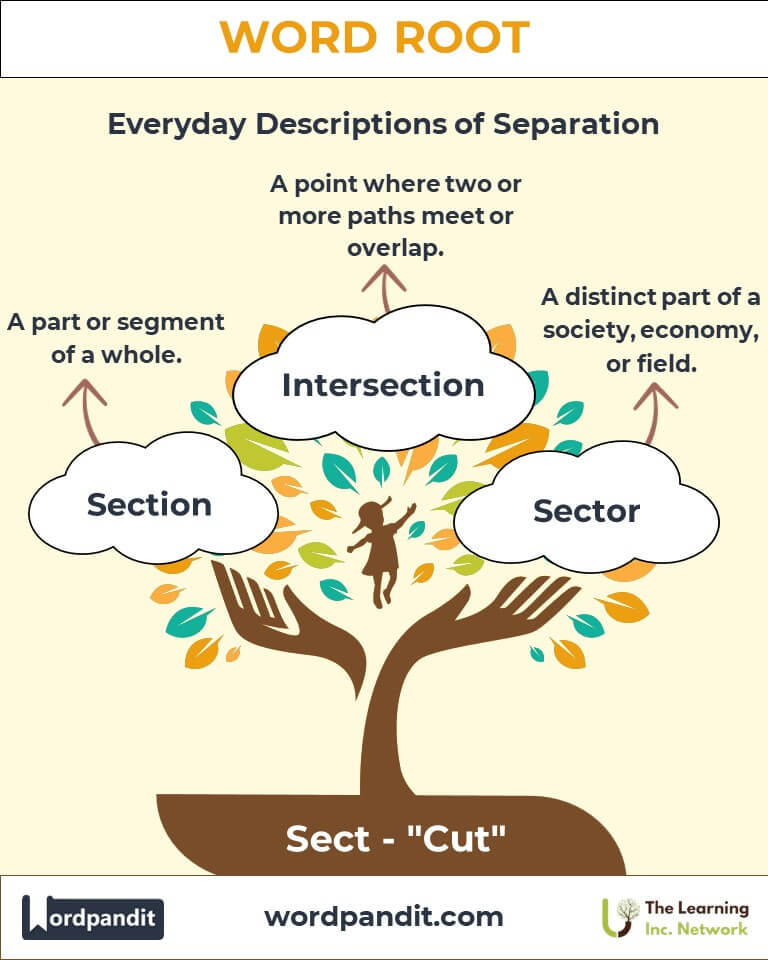Sect: The Root of Precision and Division in Language and Beyond
Byline: Discover the intriguing word root "sect," derived from the Latin sectus meaning "cut." This root forms the foundation of numerous words like "section" and "dissect," reflecting division, segmentation, and analysis. Whether in everyday usage or specialized fields like medicine and geometry, the root "sect" reveals humanity's focus on precision, understanding, and categorization.

Table of Contents
- Introduction: The Essence of Sect
- Etymology and Historical Journey
- Mnemonic: Unlocking the Power of Sect
- Common Sect-Related Terms
- Sect Through Time
- Sect in Specialized Fields
- Illustrative Story: Sect in Action
- Cultural Significance of the Sect Root
- The Sect Family Tree
- FAQs About the Sect Word Root
- Test Your Knowledge: Sect Word Root Quiz
- Conclusion: The Living Legacy of Sect
1. Introduction: The Essence of Sect
What do "sections" of a book and "dissections" in a lab have in common? Both derive from the root "sect," which originates from the Latin word sectus, meaning "cut." Pronounced as "sekt," this root encapsulates the concept of dividing or segmenting to understand or organize. From anatomy to social sciences, "sect" and its derivatives have made their mark, enabling clarity and precision in diverse fields.

2. Etymology and Historical Journey
The root "sect" comes from the Latin sectus (cut) and its verb form secare (to cut). In Roman times, the term described physical cutting, such as dividing land or trimming plants. Over centuries, it evolved to encompass abstract forms of division, such as philosophical sects and textual sections. This linguistic journey reflects the root’s broadening influence, from tangible actions to intellectual frameworks.
3. Mnemonic: Unlocking the Power of Sect
Visualize a scalpel slicing through layers to reveal intricate details beneath. This imagery helps cement the association of "sect" with cutting and analysis.
Mnemonic Device: "Sect cuts to the core—dividing, analyzing, and revealing insights."
4. Common Sect-Related Terms
- Section (sek-shun): A part or segment of a whole.
Example: "She read the introduction and skipped to the final section of the book." - Dissect (dih-sekt): To cut apart methodically for analysis.
Example: "In biology class, we dissect frogs to study their anatomy." - Intersection (in-ter-sek-shun): A point where two or more paths meet or overlap.
Example: "The intersection of Main Street and 5th Avenue is always busy." - Sector (sek-tor): A distinct part of a society, economy, or field.
Example: "The technology sector has experienced rapid growth." - Bisect (bye-sekt): To divide into two equal parts.
Example: "The artist bisected the canvas with a bold line."
5. Sect Through Time
- Secta (Medieval Latin): Referring to a way or mode of living, this term evolved into the modern concept of a "sect" or group with distinct beliefs.
- Sectionalism (19th Century): In U.S. history, this term described division based on regional interests, particularly during the Civil War era.
6. Sect in Specialized Fields
- Medicine: Dissect: To examine internal structures by cutting.
Application: Vital for surgical training and research. - Mathematics: Bisect: Dividing angles or lines into equal parts.
Application: Crucial for geometry and design. - Technology: Sector: Describes a division of a storage device like a hard drive.
Application: Key to understanding data organization.
7. Illustrative Story: Sect in Action
Dr. Elena Patel, a skilled surgeon, had to perform a critical dissection to save her patient. Every precise cut brought her closer to understanding the root cause of the issue. Meanwhile, her mathematician brother used bisection to solve a complex geometric puzzle. Though in different fields, their shared reliance on "sect" showcased its universal significance.
8. Cultural Significance of the Sect Root
The concept of "sect" resonates across cultures as a symbol of division and identity. Philosophical sects, religious groups, and political factions reflect its use in defining collective beliefs and practices. In literature, sectionalism often explores themes of unity and division within societies.

9. The Sect Family Tree
- Sec/Sicc (Latin: to cut):
- Segment: A part divided from the whole.
Example: "The pie was divided into six segments."
- Segment: A part divided from the whole.
- Tom (Greek: to cut):
- Anatomy: The study of bodily structures through cutting.
Example: "Anatomy classes often involve dissections."
- Anatomy: The study of bodily structures through cutting.
- Cis (Latin: to cut):
- Incision: A surgical cut.
Example: "The incision was carefully stitched to prevent infection."
- Incision: A surgical cut.
10. FAQs About " Sect "
Q: What does the root "sect" mean, and where does it come from?
A: The root "sect" means "cut" and originates from the Latin word sectus, derived from the verb secare (to cut). It reflects both literal cutting, as in surgery, and abstract divisions, such as groups, categories, or sections in a text.
Q: How is "sect" used in abstract contexts?
A: Beyond physical cutting, "sect" is used to describe divisions or segments in ideas, groups, or categories. For example, a "section" in a book refers to a distinct part, while a "sect" often refers to a group with distinct beliefs or practices, like a religious sect.
Q: What is the difference between "bisect" and "dissect"?
A: "Bisect" means to divide into two equal parts, typically used in geometry or everyday situations like cutting a cake. "Dissect," on the other hand, means to cut apart methodically to study its internal structure, commonly used in biology and anatomy.
Q: How is the word "sector" used in different fields?
A: In geometry, a "sector" is a part of a circle defined by two radii and the enclosed arc. In economics, a "sector" refers to a distinct part of the economy, such as the technology or healthcare sector. In computing, it describes divisions of a storage device, such as a hard disk.
Q: What is the historical significance of the term "sect"?
A: Historically, "sect" referred to a group of people united by common beliefs, often religious or philosophical. This reflects the root's meaning of "cut," symbolizing how these groups are "cut away" or differentiated from a larger whole.
Q: How does the word "intersection" relate to the root "sect"?
A: "Intersection" combines "inter" (between) and "sect" (cut), meaning a point where two or more lines, paths, or concepts "cut across" one another. It’s widely used in geometry, city planning, and social discussions.
11. Test Your Knowledge: " Sect " Mastery Quiz
1. What does the root "sect" mean?
2. Which term describes a point where two paths meet?
3. What does "bisect" mean?
4. Which field commonly uses the term "dissect"?
5. What is a sector in geometry?
12. Conclusion: The Living Legacy of Sect
The root "sect" captures the essence of division and analysis, playing a vital role in language, science, and culture. From the meticulous cuts of a surgeon to the segments of a story, "sect" helps us understand, organize, and explore the world. Embrace the power of "sect" in your journey to comprehend and create.












